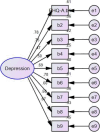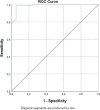A Chinese adaptation of the Patient Health Questionnaire for Adolescents (PHQ-A): factor structure and psychometric properties
- PMID: 38689265
- PMCID: PMC11061901
- DOI: 10.1186/s12888-024-05783-3
A Chinese adaptation of the Patient Health Questionnaire for Adolescents (PHQ-A): factor structure and psychometric properties
Abstract
Background: To examine the factor structure and psychometric properties of the Patient Health Questionnaire for Adolescents (PHQ-A) in Chinese children and adolescents with major depressive disorder (MDD).
Methods: A total of 248 MDD patients aged between 12 and 18 years were recruited and evaluated by the Patient Health Questionnaire for Adolescents (PHQ-A), the Center for Epidemiological Survey Depression Scale (CES-D), the Mood and Feelings Questionnaire (MFQ), and the improved Clinical Global Impression Scale, Severity item (iCGI-S). Thirty-one patients were selected randomly to complete the PHQ-A again one week later. Confirmatory factor analysis (CFA) was used to test the construct validity of the scale. Reliability was evaluated by Macdonald Omega coefficient. Pearson correlation coefficient was used to assess the item-total correlation and the correlation of PHQ-A with CES-D and MFQ respectively. Spearman correlation coefficient was used to assess test-retest reliability. The optimal cut-off value, sensitivity, and specificity of the PHQ-A were achieved by estimating the Receiver Operating Characteristics (ROC) curve.
Results: CFA reported adequate loadings for all items, except for item 3. Macdonald Omega coefficient of the PHQ-A was 0.87. The Spearman correlation coefficient of the test-retest reliability was 0.70. The Pearson correlation coefficients of the PHQ-A with CES-D and MFQ were 0.87 and 0.85, respectively (p < 0.01). By taking the iCGI-S as the remission criteria for MDD, the optimal cut-off value, sensitivity and specificity of the PHQ-A were 7, 98.7%, 94.7% respectively.
Conclusion: The PHQ-A presented as a unidimensional construct and demonstrated satisfactory reliability and validity among the Chinese children and adolescents with MDD. A cut-off value of 7 was suggested for remission.
Keywords: Adolescents; Cut-off value; Depression; Factor structure; PHQ-A; Psychometric properties.
© 2024. The Author(s).
Conflict of interest statement
The authors declare no competing interests.
Figures


Similar articles
-
Adaptation and validation of the Chinese version of the digital addiction scale for children (DASC).BMC Public Health. 2025 Jul 30;25(1):2599. doi: 10.1186/s12889-025-23817-7. BMC Public Health. 2025. PMID: 40739489 Free PMC article.
-
The Chinese version of the physical activity questionnaire for adolescents: a psychometric validity, reliability, and invariance study.BMC Public Health. 2024 Nov 11;24(1):3117. doi: 10.1186/s12889-024-20563-0. BMC Public Health. 2024. PMID: 39529046 Free PMC article.
-
Evaluating the Construct Validity and Sensitivity to Change of the Klenico Depression Domain in Psychotherapeutic Inpatient Care: Instrument Validation Study.JMIR Form Res. 2025 Jul 24;9:e50504. doi: 10.2196/50504. JMIR Form Res. 2025. PMID: 40706024 Free PMC article.
-
A diagnostic meta-analysis of the Patient Health Questionnaire-9 (PHQ-9) algorithm scoring method as a screen for depression.Gen Hosp Psychiatry. 2015 Jan-Feb;37(1):67-75. doi: 10.1016/j.genhosppsych.2014.09.009. Epub 2014 Sep 23. Gen Hosp Psychiatry. 2015. PMID: 25439733
-
Symptom screening scales for detecting major depressive disorder in children and adolescents: a systematic review and meta-analysis of reliability, validity and diagnostic utility.J Affect Disord. 2015 Mar 15;174:447-63. doi: 10.1016/j.jad.2014.11.061. Epub 2014 Dec 6. J Affect Disord. 2015. PMID: 25553406
Cited by
-
Psychosocial risk and protective factors for youth problem behavior are associated with food addiction in the Generation Z.Front Public Health. 2024 May 27;12:1414110. doi: 10.3389/fpubh.2024.1414110. eCollection 2024. Front Public Health. 2024. PMID: 38859893 Free PMC article.
-
Poor performance of PHQ-9 and GAD-7 in screening clinical depression and anxiety among a large sample of Chinese children and adolescents.BMC Psychiatry. 2025 Mar 29;25(1):301. doi: 10.1186/s12888-025-06754-y. BMC Psychiatry. 2025. PMID: 40158158 Free PMC article.
-
Longitudinal Impact of Disordered Eating Attitudes on Depression, Anxiety, and Somatization in Young Women with Anorexia and Bulimia.J Clin Med. 2024 Aug 27;13(17):5078. doi: 10.3390/jcm13175078. J Clin Med. 2024. PMID: 39274291 Free PMC article.
References
-
- Cho MJ, Seong SJ, Park JE, Chung IW, Lee YM, Bae A, Ahn JH, Lee DW, Bae JN, Cho SJ, et al. Prevalence and Correlates of DSM-IV Mental Disorders in South Korean Adults: The Korean Epidemiologic Catchment Area Study 2011. Psychiatry Investig. 2015;12(2):164–170. doi: 10.4306/pi.2015.12.2.164. - DOI - PMC - PubMed
Publication types
MeSH terms
Grants and funding
- 201904010326/Science and Technology Planning Project of Guangzhou
- 201904010326/Science and Technology Planning Project of Guangzhou
- 201904010326/Science and Technology Planning Project of Guangzhou
- 201904010326/Science and Technology Planning Project of Guangzhou
- 201904010326/Science and Technology Planning Project of Guangzhou
LinkOut - more resources
Full Text Sources

